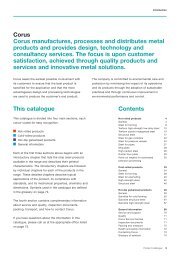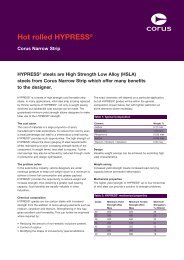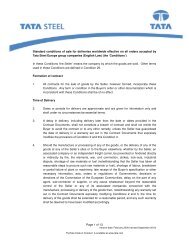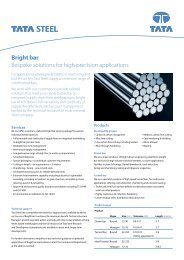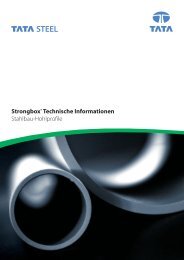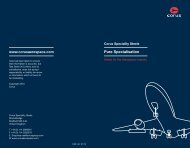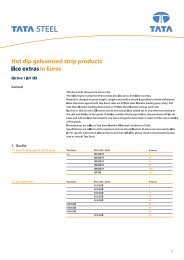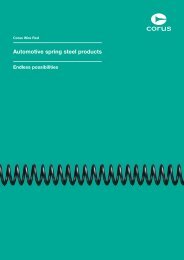SHS Jointing, Flowdrill & Hollo-Bolt - Tata Steel
SHS Jointing, Flowdrill & Hollo-Bolt - Tata Steel
SHS Jointing, Flowdrill & Hollo-Bolt - Tata Steel
You also want an ePaper? Increase the reach of your titles
YUMPU automatically turns print PDFs into web optimized ePapers that Google loves.
Corus Tubes library publication<br />
The contents of this publication are current, when republished<br />
it will be in the new Corus housestyle.
<strong>SHS</strong> <strong>Jointing</strong><br />
<strong>Flowdrill</strong> &<br />
<strong>Hollo</strong>-<strong>Bolt</strong>
<strong>Flowdrill</strong>&<strong>Hollo</strong>-<strong>Bolt</strong><br />
<strong>Flowdrill</strong> &<br />
<strong>Hollo</strong>-<strong>Bolt</strong><br />
<strong>Jointing</strong><br />
for <strong>Hollo</strong>w Sections<br />
<strong>Flowdrill</strong> and <strong>Hollo</strong>-<strong>Bolt</strong> give a choice of two<br />
methods to produce bolted joints in<br />
<strong>Hollo</strong>w Sections. Both systems offer the<br />
following benefits:<br />
● They produce bolted joints of structural<br />
capacity in Hot Finished Rectangular <strong>Hollo</strong>w<br />
Sections (HFRHS).<br />
● They minimise the change in the fabrication<br />
process by using connection details which<br />
are standard in the construction industry.<br />
● They reduce fabrication by removing the<br />
need to weld plates or other fittings onto the<br />
outside surface of the RHS.<br />
● They simplify erection by using fully threaded<br />
bolts -an increasing practice in the<br />
construction industry.<br />
● They maintain aesthetics by producing a<br />
flush face on the RHS after fabrication.<br />
Design Guidance<br />
The design guidance produced in this<br />
publication is for <strong>Flowdrill</strong> and <strong>Hollo</strong>-<strong>Bolt</strong><br />
systems with grade 8.8 bolts in conjunction with<br />
Tubes and Pipes hot finished structural hollow<br />
sections. The design guidance, for joints in<br />
simple construction, result from Tubes & Pipes<br />
initial research work undertaken in connection<br />
with CIDECT (Ref. 1). The guidance<br />
complements the information published by the<br />
BCSA/SCI and is presented in a form<br />
compatible with their publication “Joints in<br />
Simple Construction” (Ref. 2).<br />
Further test work is being undertaken to<br />
establish design guidance for semi-rigid<br />
joints.<br />
Procedural checks are given for bearing, shear<br />
and local bolt pull out of the RHS wall and for<br />
the combined effect of the column axial load<br />
and the structural integrity tensile load of<br />
BS 5950 : Part 1.<br />
The combined check for the column axial load<br />
and the structural integrity tensile load<br />
recognises that the flexibility of the RHS face<br />
caused by the tensile load can, in the presence<br />
of the column axial load, reduce the overall joint<br />
capacity.
<strong>Hollo</strong>-<strong>Bolt</strong><br />
Fabrication and<br />
<strong>Flowdrill</strong><br />
Construction<br />
General detailing recommendations for beam<br />
column connections, given in this<br />
publication, are in accordance with the<br />
BCSA/SCI publication -”Joints in Simple<br />
Construction” (Ref. 2).<br />
Both <strong>Flowdrill</strong> and <strong>Hollo</strong>-<strong>Bolt</strong> use fully threaded<br />
bolts which allows standardisation of bolt<br />
lengths throughout the construction. Where<br />
beams are connected to adjacent faces of an<br />
RHS column a check must be made with the<br />
chosen bolt length to ensure that assembly is<br />
possible (see Fig. 3 and 6) and the bolts do<br />
not touch.<br />
Both <strong>Flowdrill</strong> and <strong>Hollo</strong>-<strong>Bolt</strong> are suitable for use<br />
with the two standard grades of Tubes & Pipes<br />
<strong>SHS</strong> to BS EN10210-1 of S275J2H and<br />
S355J2H (formerly BS4360 Gr43D and 50D<br />
respectively).<br />
At present, application of the <strong>Flowdrill</strong> process<br />
is limited to RHS thicknesses up to and<br />
including 12.5mm. For thicknesses of 16mm<br />
and over, conventional drill and tap methods are<br />
recommended, although due to the RHS<br />
material strength being lower than that of the<br />
grade 8.8 bolts, pull out strengths may be below<br />
the bolt tension capacity.<br />
Reference<br />
1. Comité International pour le<br />
Développment et l’Étude de la<br />
Construction Tubulaire<br />
UK Member<br />
British <strong>Steel</strong> plc<br />
Tubes & Pipes<br />
PO Box 101<br />
Corby<br />
Northants NN17 5UA<br />
2. Joints in Simple Construction<br />
Volume 1 : Design methods<br />
Volume 2 : Practical applications<br />
Published jointly by:<br />
BCSA SCI<br />
4 Whitehall Court Silwood Park<br />
Westminster Ascot<br />
London Berks SL5 7QN<br />
SW1A 2ES
<strong>Flowdrill</strong><br />
<strong>Flowdrill</strong><br />
The<br />
Process<br />
<strong>Flowdrill</strong>ing is basically a thermal drilling<br />
process which makes a hole through the<br />
wall of a structural hollow section without<br />
the removal of metal normally associated<br />
with a drilling process. The formed hole is<br />
then threaded by the use of a roll thread<br />
forming tool, leaving a threaded hole which<br />
will accept a standard fully threaded bolt.<br />
The Tools<br />
The initial hole is made by a <strong>Flowdrill</strong> tool<br />
consisting of a tungsten carbide bit held in a<br />
<strong>Flowdrill</strong> Morsetaper collet adaptor (Fig. 1). The<br />
tool can be used in a conventional drilling<br />
machine or CNC machine as found in<br />
fabricators works, provided it has adequate<br />
horsepower and spindle speed.<br />
1st stage<br />
The tungsten carbide bit is brought into contact<br />
with the RHS wall where it generates sufficient<br />
heat to soften the steel. The bit is then<br />
advanced through the wall and in so doing the<br />
metal is redistributed (or flows) to form an<br />
internal bush. As well as drilling the initial hole,<br />
the tool is fitted with the means of removing any<br />
surplus material which may arise on the outside<br />
of the RHS section. The cycle time for<br />
<strong>Flowdrill</strong>ing is similar to that for conventional<br />
drilling. However, if done on CNC machines the<br />
feed rate can be slow at the beginning, rapidly<br />
increasing as the material softens to improve<br />
efficiency.<br />
2nd stage<br />
The 2nd and final stage is to tap the <strong>Flowdrill</strong><br />
bush. This is done by roll threading the bush<br />
with a Coldform Flowtap. The complete cycle is<br />
shown in Figure 2.<br />
Fig. 2<br />
Tool holder<br />
<strong>Flowdrill</strong> data :<br />
The <strong>Flowdrill</strong> system was developed by <strong>Flowdrill</strong> BV in Holland, and is available in the UK from<br />
their agent - Robert Speck Ltd,. Little Ridge, Whittlebury Road, Silverstone, Northants NN12 8UD.<br />
Tel: 01327 857307 Contact Mr Mike Carpenter.<br />
Fig. 1<br />
Collet<br />
<strong>Flowdrill</strong> bit<br />
1st Stage 2nd Stage
Drilling machine parameters :<br />
Table 1 gives a guide to required machine<br />
parameters for producing <strong>Flowdrill</strong> holes for<br />
M12 to M24 bolts:<br />
Note: The <strong>Flowdrill</strong> process is not suitable for<br />
hand held or magnetic clamp type drilling<br />
equipment when used in the sizes shown.<br />
Max material<br />
thickness<br />
(mm)<br />
<strong>Flowdrill</strong> detailing requirements.<br />
See Fig. 3 and Table 3.<br />
Note:<br />
3<br />
5<br />
6<br />
8<br />
10<br />
12<br />
16<br />
Table 2<br />
● <strong>Flowdrill</strong>ed joints used at<br />
locations exposed to the<br />
weather should not be<br />
considered as water tight.<br />
● <strong>Flowdrill</strong>ing is not suitable<br />
for use with pre-galvanised<br />
materials.<br />
Dimensions<br />
(mm)<br />
A 1<br />
B 1<br />
C 1<br />
D 1<br />
E 1 Minimum<br />
Min <strong>Bolt</strong> Centres<br />
M12<br />
Short<br />
Long<br />
Long<br />
Long<br />
-<br />
-<br />
-<br />
<strong>Flowdrill</strong> Length<br />
M16<br />
Short<br />
Short<br />
Long<br />
Long<br />
Long<br />
-<br />
-<br />
Thread Size<br />
M12<br />
7<br />
13<br />
18<br />
30<br />
M20<br />
Short<br />
Short<br />
Short<br />
Long<br />
Long<br />
Long<br />
-<br />
Lb<br />
tp<br />
M24<br />
Short<br />
Short<br />
Short<br />
Long<br />
Long<br />
Long<br />
-<br />
tc<br />
M16<br />
10<br />
17<br />
20<br />
40<br />
Thread size<br />
<strong>Flowdrill</strong> size<br />
M/c spindle<br />
speed rpm<br />
M/c feed rate<br />
Motor power<br />
KW Min<br />
Tapping speed<br />
rpm<br />
Table 3 (See Fig. 3 for nomenclature)<br />
M12<br />
10.9<br />
1000-1500<br />
2<br />
250<br />
M16<br />
14.8<br />
700-1100<br />
Table 1<br />
Drill length: The recommended length of<br />
<strong>Flowdrill</strong> bits varies with the thread size and<br />
thickness of material as given in Table 2.<br />
Drill care: <strong>Flowdrill</strong>s are made from tungsten<br />
carbide. They are extremely hard but cannot<br />
withstand shock loads. After drilling each hole,<br />
FD KS paste should be applied to the <strong>Flowdrill</strong><br />
whilst it is still hot, so minimising oxidation and<br />
preventing ‘build up’ on the surface.<br />
Flat surface: the raised rim on the outer surface<br />
of the RHS material caused during <strong>Flowdrill</strong>ing<br />
should be removed using <strong>Flowdrill</strong>s with cutting<br />
edges provided on the collar. One rotation of the<br />
cutter is all that is required to remove the rim.<br />
B 1<br />
C 1<br />
Width<br />
Min bolt centres<br />
Thread size/<strong>Bolt</strong> diameter<br />
2.5<br />
200<br />
M20<br />
18.7<br />
600-1000<br />
3.5<br />
150<br />
M24<br />
22.5<br />
500-800<br />
0.1/0.15mm (0.004/0.006 inches) per rev<br />
M20<br />
12<br />
22<br />
26<br />
Varies with overall bolt length (Lb) specified<br />
C 1/2 + t c (for connection made to a single face or opposite faces)<br />
B 1/2 + A 1 + D 1 + t c (for connection made to adlacent faces)<br />
A 1<br />
D 1<br />
50<br />
E 1<br />
M24<br />
15<br />
25<br />
29<br />
60<br />
5<br />
100<br />
Fig. 3<br />
E 1
<strong>Hollo</strong>-<strong>Bolt</strong><br />
<strong>Hollo</strong>-<strong>Bolt</strong><br />
HOLLO-BOLT is a pre-assembled<br />
three part fitting consisting of body,<br />
cone and bolt.<br />
The pre-assembled unit (Fig. 4) is<br />
inserted through normal tolerance holes<br />
in both the attatchment plate and the<br />
RHS. As the bolt is tightened the cone is<br />
drawn into the body, spreading the legs,<br />
and forming a secure fixing. Once<br />
installed only the <strong>Hollo</strong>-<strong>Bolt</strong> head and<br />
collar are visible (Fig. 5).<br />
The <strong>Hollo</strong>-<strong>Bolt</strong><br />
Location Flats<br />
Body<br />
Cone Knurling<br />
Further information on<br />
<strong>Hollo</strong>-<strong>Bolt</strong> is available from<br />
Fig. 5<br />
Fig. 4<br />
Hexagon Head<br />
Collar<br />
Fixture<br />
RHS<br />
Cone<br />
Legs<br />
Central <strong>Bolt</strong><br />
Lindapter International<br />
A Division of Victaulic plc.,<br />
Lindsay House, Brackenbeck Road,<br />
Bradford, West Yorkshire, Tel: 01274 521444<br />
England, BD7 2NF Fax: 01274 521130
V<br />
tp<br />
Drilling requirements:<br />
<strong>Hollo</strong>-<strong>Bolt</strong> uses a plain drilled<br />
hole which can be made on<br />
site or in the fabrication shop<br />
using all normal drilling<br />
equipment. The finished hole<br />
should have a tolerance of<br />
-0.2mm to +1.0mm from the<br />
nominal given in the data table<br />
(Table 4).<br />
tc<br />
Material Options<br />
Standard product is manufactured from mild<br />
steel and is electro-zinc plated with the addition<br />
of JS500 1000 hour saltspray corrosion<br />
protection. The central fastener is a grade<br />
8.8 bolt.<br />
For special applications, the <strong>Hollo</strong>-<strong>Bolt</strong> is<br />
available manufactured from 316 stainless steel,<br />
with a grade A4-80 central bolt. This will not be a<br />
stocked item, and would be manufactured to<br />
order.<br />
Installation<br />
The only tools required to fit <strong>Hollo</strong>-<strong>Bolt</strong> are two<br />
spanners - an open ended spanner to hold the<br />
collar and a torque wrench to tighten the central<br />
bolt. Alternatively a power operated electric<br />
hand tool is in development.<br />
Should the steelwork need to be adjusted,<br />
the fixing can simply be removed and the<br />
hole reused with another <strong>Hollo</strong>-<strong>Bolt</strong>.<br />
Sealing Options<br />
Width<br />
X<br />
<strong>Bolt</strong><br />
size<br />
In certain applications, it may be necessary to<br />
seal the <strong>Hollo</strong>-<strong>Bolt</strong> to prevent ingress of water or<br />
other corrosive agents. For details of sealing<br />
options available, please contact Lindapter.<br />
Special Options (manufactured to order)<br />
● Stainless steel<br />
● Button head setscrew ● Socket head capscrew<br />
● Countersunk setscrew/body ● Special body lengths<br />
Y<br />
M8<br />
M10<br />
M12<br />
M16<br />
M20<br />
<strong>Bolt</strong><br />
length<br />
(V)<br />
W<br />
mm<br />
45<br />
49<br />
53<br />
57<br />
80<br />
Fixing<br />
thickness<br />
(W)<br />
Min Max<br />
mm<br />
3 22<br />
3 22<br />
3 25<br />
3 28<br />
3 34<br />
Fig. 6<br />
E 1<br />
<strong>Bolt</strong><br />
centres<br />
(X)<br />
Min<br />
mm<br />
35<br />
40<br />
50<br />
55<br />
70<br />
Internal<br />
min. edge<br />
distance<br />
(Y)<br />
mm<br />
13<br />
15<br />
18<br />
20<br />
25<br />
Edge<br />
distance<br />
(E1)<br />
Min<br />
mm<br />
50-tp<br />
55-tp<br />
60-tp<br />
65-tp<br />
90-tp<br />
<strong>Bolt</strong><br />
hole<br />
dia.<br />
(Dh )<br />
mm<br />
Table 4 (See Fig. 6 for nomenclature)<br />
14<br />
18<br />
20<br />
26<br />
33<br />
Across<br />
flats<br />
main<br />
body<br />
mm<br />
19<br />
24<br />
30<br />
36<br />
46<br />
Fig. 7<br />
Tightening<br />
torque<br />
Nm<br />
21<br />
40<br />
78<br />
190<br />
300
Design of<br />
Joints in<br />
Simple<br />
Construction<br />
Simple connections between Universal<br />
beams and RHS columns can be made<br />
using double angle web cleats or<br />
flexible end plates.<br />
The following procedural checks are<br />
compatible with the BCSA/SCI rules for<br />
Joints in Simple Construction (Ref. 2).<br />
Length of cleat<br />
I ≥ 0.6D<br />
Cleat thickness, t p<br />
t p = 8mm or 10mm<br />
Notes<br />
Double Angle Cleats Flexible End Plates<br />
End projection t 1 , approx 10mm<br />
Face of column Length of plate<br />
I ≥ 0.6D<br />
Face of column<br />
D I<br />
D I<br />
g <strong>Bolt</strong> diameter, d g<br />
<strong>Bolt</strong> diameter, d<br />
<strong>Flowdrill</strong> hole diameter, D h<br />
D h = d+2mm for d ≤ 24mm<br />
D h = d+3mm for d > 24mm<br />
For <strong>Hollo</strong>-<strong>Bolt</strong> D h see Table 4.<br />
Plate thickness, t p<br />
t p = 8mm or 10mm<br />
● The cleats or end plates are generally positioned as close to the top flange<br />
of the beam as possible to provide adequate positional restraint and a plate<br />
length of at least 0.6D is usually adopted to give adequate torsional restraint<br />
(BS 5950: Part 1, Table 9).<br />
● <strong>Bolt</strong> gauge g: 90mm ≤ g ≤ 140mm, but g ≥ 0.3 x RHS face width B.<br />
● Although it may be possible to satisfy the design requirements with t p < 8mm,<br />
it is not recommended in practice because of the likelihood of weld<br />
distortion during fabrication and damage during transportation.<br />
● The plate thickness and gauge limitations apply equally to partial depth and<br />
to full depth end plates.<br />
If necessary, to comply with structural integrity requirements for a 75 kN tie force,<br />
the connection must have at least 2 no. M20, Grade 8.8 bolts in tension with<br />
/ ≥ 140mm, t ≥ 8mm and g ≤ 140mm.
Local shear and bearing capacity of the<br />
RHS column wall and bolts.<br />
Basic Requirement<br />
For Shear<br />
Q_ 2<br />
≤ Pv Pv = local shear capacity of<br />
RHS column wall<br />
= smaller of 0.6pyc Av and<br />
0.5 Usc Avnet Av = [g/2 + (n -1) p = et] tc with [et ≤ 5 d]<br />
Avnet = Av- n d tc n = number of rows of bolts<br />
p = bolt pitch<br />
d = nominal bolt diameter (or<br />
hole diameter in RHS<br />
columns for <strong>Hollo</strong>-<strong>Bolt</strong>)<br />
g = bolt gauge width<br />
tc = RHS column wall<br />
thickness<br />
pyc = design strength of RHS<br />
colunm wall (S275 = 275<br />
N/mm2 : S355 =<br />
355 N/mm2) Usc = ultimate tensile strength<br />
of RHS column wall<br />
For bearing<br />
Q_ 2<br />
≤ Pbsc Pbsc = bearing capacity of the RHS<br />
column wall per bolt = d tc pbsc pbsc = bearing strength of the RHS<br />
column wall (S275 =<br />
460 N/mm2 : S355 = 550 N/mm2) <strong>Bolt</strong> diameter<br />
-<br />
-<br />
M12<br />
M16<br />
M20<br />
M24<br />
<strong>Flowdrill</strong><br />
kN<br />
-<br />
-<br />
31.6<br />
58.9<br />
91.9<br />
132<br />
<strong>Bolt</strong> diameter<br />
M8<br />
M10<br />
M12<br />
M16<br />
M20<br />
-<br />
<strong>Flowdrill</strong><br />
kN<br />
12<br />
25<br />
38<br />
75<br />
100<br />
-<br />
e t<br />
Q<br />
t c<br />
n rows<br />
of bolts<br />
<strong>Bolt</strong> Check (Table 5)<br />
Critical sections<br />
The single shear capacity for <strong>Flowdrill</strong> and<br />
<strong>Hollo</strong>-<strong>Bolt</strong> can be taken as follows:-<br />
g<br />
Q/2 Q/2<br />
p<br />
p<br />
p
<strong>Bolt</strong><br />
diameter<br />
mm<br />
M16<br />
M20<br />
M24<br />
<strong>Bolt</strong><br />
diameter<br />
mm<br />
M16<br />
M20<br />
M24<br />
5<br />
46<br />
70<br />
80<br />
Structural integrity-local bolt pull-out<br />
of RHS colmn wall.<br />
Note: This check is only needed if it is<br />
necessary to comply with structural<br />
integrity requirements.<br />
Basic Requirement<br />
Tie force ≤∑Local bolts pull-out<br />
resistances<br />
∑ Local bolt pull-out resistances<br />
= 2 n Pp(si) The local bolt pull-out design resistance<br />
in kN of a grade 8.8 bolt in a flowdrilled<br />
hole or a <strong>Hollo</strong>-<strong>Bolt</strong> should be taken from<br />
the following tables which are based on<br />
test results:<br />
<strong>Flowdrill</strong> normal design strength (P p(n) kN<br />
RHS column wall thickness t c mm<br />
Grade S275 (Grade 43) Grade S355 (Grade 50)<br />
6.3<br />
60<br />
85<br />
101<br />
8<br />
95<br />
122<br />
10<br />
70<br />
97<br />
134<br />
12.5<br />
110<br />
159<br />
5<br />
59<br />
102<br />
103<br />
6.3<br />
130<br />
<strong>Flowdrill</strong> structural integrity design strength (P p(si) kN<br />
5<br />
30<br />
46<br />
53<br />
RHS column wall thickness t c mm<br />
70<br />
110<br />
8-12.5<br />
159<br />
Grade S275 (Grade 43) Grade S355 (Grade 50)<br />
6.3<br />
40<br />
56<br />
67<br />
8<br />
63<br />
81<br />
<strong>Bolt</strong><br />
diameter<br />
mm<br />
M8<br />
M10<br />
M12<br />
M16<br />
M20<br />
10<br />
46<br />
65<br />
89<br />
Table 6<br />
Table 7<br />
12.5<br />
73<br />
106<br />
5<br />
39<br />
68<br />
68<br />
6.3<br />
86<br />
<strong>Hollo</strong>-<strong>Bolt</strong> design strengths<br />
Normal design<br />
strength (P p(n) )<br />
kN<br />
16<br />
26<br />
38<br />
70<br />
110<br />
Table 8<br />
46<br />
73<br />
8-12.5<br />
106<br />
Structural integrity<br />
design strength (P p(si) )<br />
kN<br />
10<br />
17<br />
25<br />
46<br />
73<br />
n rows of<br />
bolts (critical<br />
bolts are<br />
those in<br />
the column)<br />
Note:<br />
Tie force<br />
1. The tension capacity of Grade 8.8 bolts for<br />
normal design and for structural integrity<br />
design is shown in the shaded areas.<br />
2. The pull-out resistances for structural<br />
integrity Pp(si) are less than those for normal<br />
design because the design method<br />
presented here for structural integrity leads<br />
to thinner cleats or end plates than for<br />
normal design methods, based on BS 5950:<br />
Part 1, and, as a result, will lead to higher<br />
prying forces. This has been taken into<br />
account in the quoted resistances.
Structural integrity - tie force<br />
capacity of RHS column wall in the<br />
presence of axial compression in the<br />
column.<br />
Note: This check is only needed if it is<br />
necessary to comply with structural<br />
integrity requirements.<br />
Basic Requirement<br />
Tie force ≤ Tying capacity of RHS column<br />
wall<br />
Tying capacity of RHS column wall<br />
8 m u<br />
= (� 1+ 1.5 (1 - � 1) 0.5 (1 - � 1) 0.5)<br />
(1 - � 1)<br />
M u = moment capacity of RHS<br />
column wall per unit length<br />
p yc t c 2<br />
=<br />
4<br />
p yc = design strength of the RHS column<br />
(S275 = 275 N/mm 2 : S355 = 355 N/mm 2)<br />
tc = thickness of RHS column wall<br />
�1 n<br />
= (n - 1)p - d<br />
2<br />
(B - 3tc )<br />
� 1<br />
� 1<br />
=<br />
=<br />
g<br />
(B - 3t c )<br />
d<br />
(B - 3t c )<br />
B = overall width of RHS column<br />
wall to which the connection is<br />
made.<br />
d = bolt diameter (or hole diameter<br />
in RHS column for <strong>Hollo</strong>-<strong>Bolt</strong>)<br />
g = bolt gauge width<br />
n = number of rows of bolts<br />
p = bolt pitch<br />
p<br />
Yield lines<br />
(n-1)p<br />
<strong>Bolt</strong> holes<br />
deducted<br />
B<br />
g<br />
Tie force<br />
(applied at<br />
bolt positions)<br />
t c<br />
1.5 t c
British <strong>Steel</strong><br />
Tubes & Pipes<br />
PO Box 101, Weldon Road,<br />
Corby, Northants, NN17 5UA<br />
Tel: 01536 402121<br />
Fax: 01536 404111<br />
British <strong>Steel</strong> plc Registered Office: 9 Albert Embankment, London, SE1 7SN Reg. in England No: 2280000<br />
TD 384.12E.95




